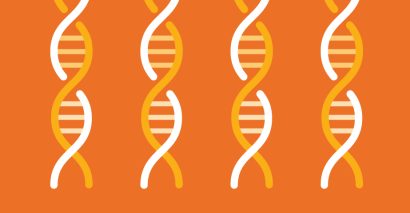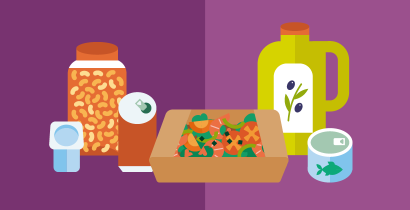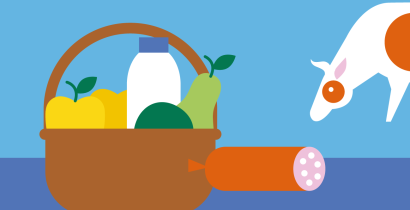Applications of biotechnology in the food industry: Enzymes
Last Updated : 06 September 2006Each week, every European eats an average of 11 kg of food. Enzymes, the naturally-occurring proteins which allow all the biochemical processes of life to occur, are found in all food raw materials. When purified and used in food preparation, some of these enzymes offer benefits such as improved flavour, texture and digestibility.
Background
For many thousands of years, man has used naturally occurring micro-organisms - bacteria, yeasts and moulds - and the enzymes they produce to make foods such as bread, cheese, beer and wine. For example in bread-making the enzyme, amylase, is used to break down flour into soluble sugars, which are transformed by yeast into alcohol and carbon dioxide. This makes the bread rise.
Today, enzymes are used for an increasing range of applications: bakery, cheese making, starch processing and production of fruit juices and other drinks. Here, they can improve texture, appearance and nutritional value, and may generate desirable flavours and aromas. Currently-used food enzymes sometimes originate in animals and plants (for example, a starch-digesting enzyme, amylase, can be obtained from germinating barley seeds) but most come from a range of beneficial micro-organisms.
In food production, enzymes have a number of advantages:
- They are welcomed as alternatives to traditional chemical-based technology, and can replace synthetic chemicals in many processes. This can allow real advances in the environmental performance of production processes, through lower energy consumption and biodegradability.
- They are more specific in their action than synthetic chemicals. Processes which use enzymes therefore have fewer side reactions and waste by-products, giving higher quality products and reducing the likelihood of pollution.
- They allow some processes to be carried out which would otherwise be impossible. An example is the production of clear apple juice concentrate, which relies on the use of the enzyme, pectinase.
Where enzymes are produced from micro-organisms (the main types include species of Bacillus, Aspergillus, Streptomyces and Kluyveromyces), these are grown by fermentation in large vats or fermenters with capacities of up to 150,000 litres; here, temperature, nutrients and air supplies are adjusted to suit their optimal development. As in other parts of the food chain, strict rules of hygiene are followed. When the process is complete, the fermenter contains a broth which includes enzymes, nutrients and microbes. This is purified by passing it through a series of filters to remove impurities and extract the enzyme.
Making improved products
Since the early 1980s, companies which produce enzymes have been using genetic engineering techniques to improve production efficiency and quality and to develop new products. There are clear advantages here for both industry and consumers, with major improvements in enzyme production giving better products and processes. However, progress is being slowed down because the debate on some other, more controversial applications of biotechnology - such as genetic engineering in animals - is continuing throughout Europe.
At present, modern biotechnology can be used to give a range of advances in enzymatic production technology:
- Improved productivity and cost-effectiveness in existing processes. By producing enzymes more efficiently, the amount of raw materials, energy and water needed to make a product can be reduced by as much as one-half by changing from a traditional strain of microbe to a genetically modified one.
- Companies can tailor their enzymes more precisely to customer demands for products with specific properties.
- Manufacturers can supply enzymes which otherwise could not be produced in large enough quantities, giving the consumer access to a wider variety of products. An example is the amylase-based product which makes bread stay fresh for longer.
Short history of enzymes
2000 BC
The Egyptians and Sumerians developed fermentation for use in brewing, bread-baking and cheese-making.
800 BC
Calves' stomachs and the enzyme, chymosin, were used for cheese-making.
1878
The components of yeast cells which cause fermentation were identified and the term "enzyme" was first used, derived from the Greek term meaning "in yeast".
1926
Enzymes were first shown to be proteins.
1980s
Enzyme preparations were developed to improve the digestibility and nutrient-availability of certain animal feeds.
1982
The first food application of a product of gene technology, alpha-amylase, took place.
1988
Recombinant chymosin was approved and introduced in Switzerland, marking an early approval of a product of gene technology for a food use.
1990
Two food processing aids obtained using gene technology: an enzyme for use in cheese-making in the US, and a yeast used in baking in the UK.
The possibility of allergies
To date, there have been no reports of consumer allergies to enzyme residues in food. The levels of enzyme residues appearing in foods are so low that they are highly unlikely ever to cause allergies. Like all proteins, enzymes can cause allergic reactions when people have been sensitised through exposure to large quantities. For this reason, enzyme companies take a variety of protective measures and some enzymes are produced as liquids, granules, in capsules or as immobilised preparations to limit worker exposure.
Some uses of enzymes in food production
| Market | Enzyme | Purpose / function |
| Dairy | Rennet (protease) | Coagulant in cheese production |
| Lactase | Hydrolysis of lactose to give lactose-free milk products | |
| Protease | Hydrolysis of whey proteins | |
| Catalases | Removal of hydrogen peroxide | |
| Brewing | Cellulases, beta-glucanases, alpha amylases, proteases, maltogenic amylases | For liquefaction, clarification and to supplement malt enzymes |
| Alcohol production | Amyloglucosidase | Conversion of starch to sugar |
| Baking | Alpha-amylases | Breakdown of starch, maltose production |
| Amyloglycosidases | Saccharification | |
| Maltogen amylase (Novamyl) | Delays process by which bread becomes stale | |
| Protease | Breakdown of proteins | |
| Pentosanase | Breakdown of pentosan, leading to reduced gluten production | |
| Glucose oxidase | Stability of dough | |
| Wine and fruit juice | Pectinase | Increase of yield and juice clarification |
| Glucose oxidase | Oxygen removal | |
| Beta-glucanases | ||
| Wine and fruit juice | Pectinase | Increase of yield and juice clarification |
| Glucose oxidase | Oxygen removal | |
| Beta-glucanases | ||
| Meat | Protease | Meat tenderising |
| Papain | ||
| Protein | Proteases, trypsin, aminopeptidases | Breakdown of various components |
| Starch | Alpha amylase, glucoamylases, hemicellulases, maltogenic amylases, glucose isomerases | Modification and conversion (eg to dextrose or high fructose syrups) |
| dextranases, beta-glucanases | ||
| Inulin | Inulinases | Production of fructose syrups |
Marketed enzymes produced using gene technology
| Principal enzyme activity | Application |
| Alpha-acetolactate decarboxylase | Brewing |
| Alpha-amylase | Baking, brewing, distilling, starch |
| Catalase | Mayonnaise |
| Chymosin | Cheese |
| Beta-glucanase | Brewing |
| Alpha-glucanotransferase | Starch |
| Glucose isomerase | Starch |
| Glucose oxidase | Baking, egg mayonnaise |
| Hemicellulase | Baking |
| Lipase | Fats, oils |
| Maltogenic amylase | Baking, starch |
| Microbial rennet | Dairy |
| Phytase | Starch |
| Protease | Baking, brewing, diary, distilling, fish, meat, starch, vegetable |
| Pullulanase | Brewing, starch |
| Xylanase | Baking, starch |



